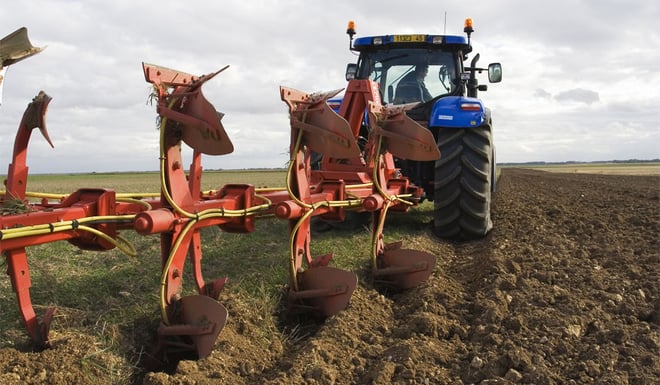The contact area with the ground beneath the four tyres of a tractor is relatively low, in proportion to the size, the load and the power of the machine. Yet it is this small area that will allow power to be transmitted to the ground and generate the work effort, the traction of heavy implements, acceleration and torque. There are only a few lugs in contact with the ground at the same time and yet your vehicle anchors itself to the ground through these. It is then that you realise the importance of a few square centimetres more, or less, to improve work efficiency, which is the exactly the importance of the section width of your agricultural tyres.
In this article we look at everything you need to know about the section width.
1. What is the nominal section width of an agricultural tyre?
You will find the section width information marked on the tyre’s sidewall. This corresponds with the first figure “710” expressed in millimetres, present in the series of numbers and letter in the image below “710/70 R 38”.
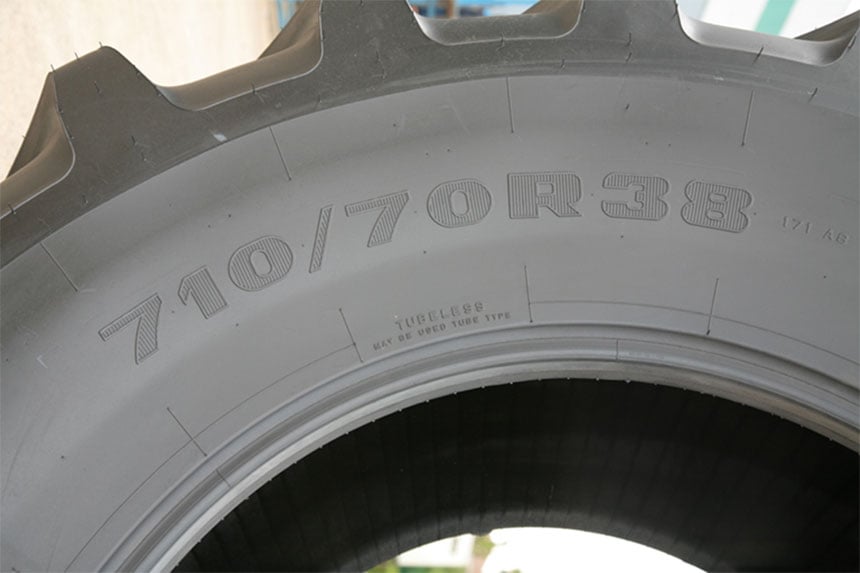
of the section width which corresponds to 710 mm
Contrary to common believe, the section width does not correspond to the width of the tread placed on the ground, but to the total width of the tyre, measured in millimetres from sidewall to sidewall of a tyre with no load.
This means that a 520/85 R38 tyre model may have a nominal section width of 520 effective millimetres, but this will be higher than the actual width of the tread which is in contact with the ground.
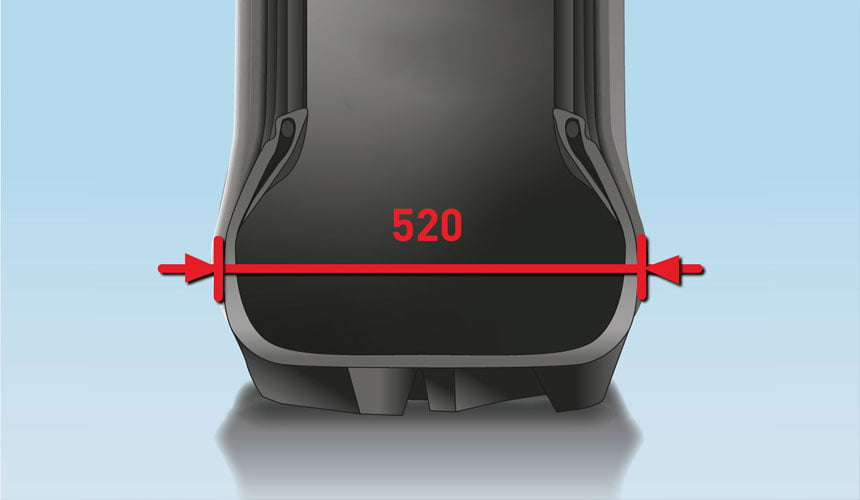
for this standard 520/85 R38 tyre
The SECTION WIDTH used to be indicated in inches
European tyre standards have made it possible to harmonise the markings on the sidewalls of tyres which used to be indicated in inches. Inches are still used for certain tyres manufactured in countries outside of the European Union. For example, a tyre marked 18.4 R38 is equivalent to a 460/85 R38 tyre.
Below is an inches to millimetres conversion table: 1 inch = 25.4mm
Section width in inches converted into millimetres
| TRACTOR TYRES |
INDUSTRIAL TYRES |
HARVESTER TYRES |
|||||
| Inches | Millimetres | Inches | Millimetres | Inches | Millimetres | ||
| 9,5 | 250/85 | 17,5 | 460/ | 23,1 | 620/ | ||
| 11,2 | 280/85 | 19,5 | 500/ | 24,5 | 650/ | ||
| 12,4 | 320/85 | ||||||
| 13,6 | 340/85 | ||||||
| 14,9 | 380/85 | ||||||
| 16,9 | 420/85 | ||||||
| 18,4 | 460/85 | ||||||
| 20,8 | 520/85 | ||||||
2. Can the section width vary?
The section width of a tyre may vary depending on multiple factors, ranging from the structure of the tyre to the conditions in which it is used.
The variation does not occur specifically at the level of the tread, which stays more or less the same, but rather in the soil footprint generated by the tyre, depending on the extent to which it is crushed into the ground, either due to an increase in the load or a decrease in the inflation pressure.
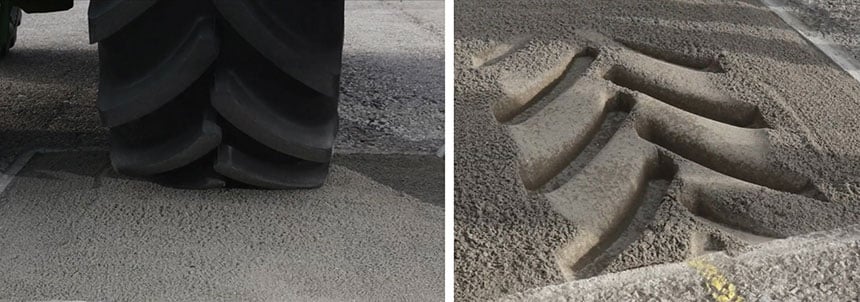
the section width in contact with the ground
What type of casing construction has an impact on the section width of a tyre?
There are two types of tyre structure used in agricultural tyre models; radial tyres and diagonal or bias-ply tyres.
Bias-ply casing provides a more rounded shape because the layers of fabric used extend from one sidewall to the other, leading to overall rigidity.
When this type of tyre is placed on the ground, the centre of the tread will have more impact on the width of the footprint and will therefore be further from the dimensions of the tyre’s section width.
This will be less the case with a radial tyre which works much more flat on the ground.
The impact of tyre technology
In the same way as the type of casing, the technology used to manufacture your tyre will also have an impact on the section width and as such on the size of the soil footprint.
A VF technology tyre, such as the VT-TRACTOR tyre, will effectively have a much greater capacity to work at low pressure than a standard tyre, so the section width, measured from sidewall to sidewall, will vary more than in a standard tyre of the same size, which will stay more rigid.
The impact of pressure settings
Whatever the tyre technology, the inflation pressure will have an impact on the section width.
High pressure will tend to rigidify the tyre at the level of the sidewalls, which will be more vertical, with a narrower soil footprint (well suited to driving on the road for example).
A lower inflation pressure with sidewalls that expand will enlarge the soil footprint (well suited to work in the fields.
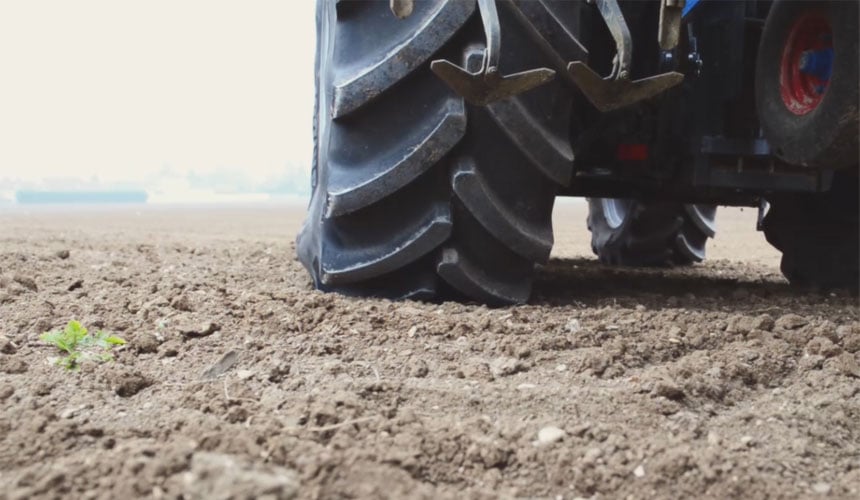
Yes, the section width will vary and it’s rather a good thing
Whatever the reason for the variation in the section width, if it expands, even by a few centimetres, the result will be an enlargement of the soil footprint.
This will lead to time saving, fuel savings and better traction, a reduction in the slip rate and, at the end of the day, better overall productivity.
3. Is there a tyre with a tread width on the ground that corresponds to the marking on its sidewall?
Bridgestone’s new VX-R TRACTOR tyre range is the fruit of research and development work carried out to obtain a new casing model.
With this range of tyres you effectively have a section width that corresponds to the tread width in contact with the soil.
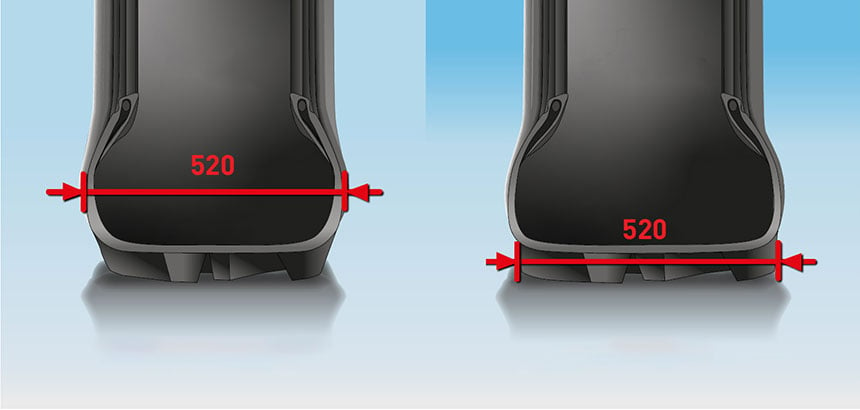
corresponds to the tread width in contact with the ground,
unlike the standard tyre on the left
Here are the advantages of this major development:
Better transmission of power to the ground
Each additional centimetre of lug gripping onto the soil will mechanically improve the transmission of engine power to the ground.
That is the advantage of this evolution, with an effective section width on the ground (for the same size with any other model) the VX-R TRACTOR tyre will have a better traction capacity that will allow you to save time completing work in your entire field.
As there is better transmission of power to the ground, your energy efficiency will also improve.
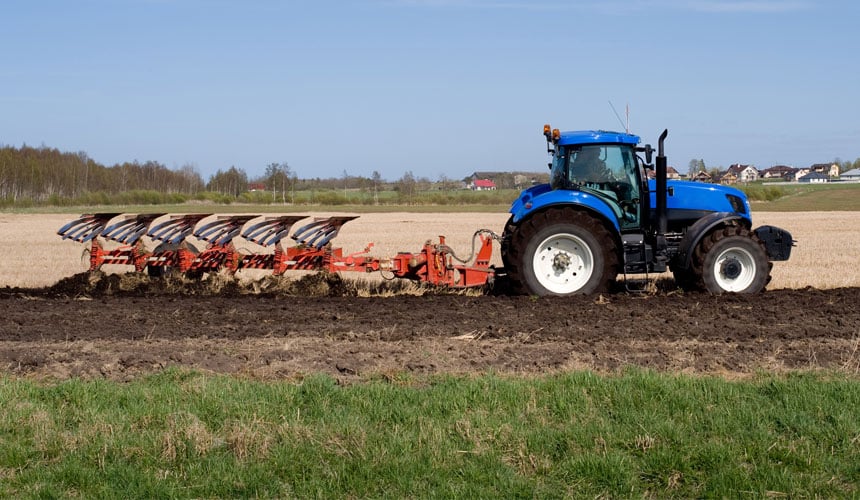
Better slip control
When your tractor starts to slip, the work becomes more tricky, with the tyres sealing over the arable layers of soil, a loss of efficiency and steering that becomes less responsive.
If the weather conditions take a turn for the worse, the campaign becomes a nightmare.
The slip ratio, which is directly linked to the tyres, slows you down and it is at this point that every little detail counts.
A low pressure tyre that is perfectly suited to your combination vehicle is of course an important factor, but the section width in contact with the ground will also have an impact.
That is one of the advantages of the VX-R TRACTOR tyre which, with a tyre size the same as its competitors, will have a larger contact area with the ground and therefore the capacity to reduce tyre slip.
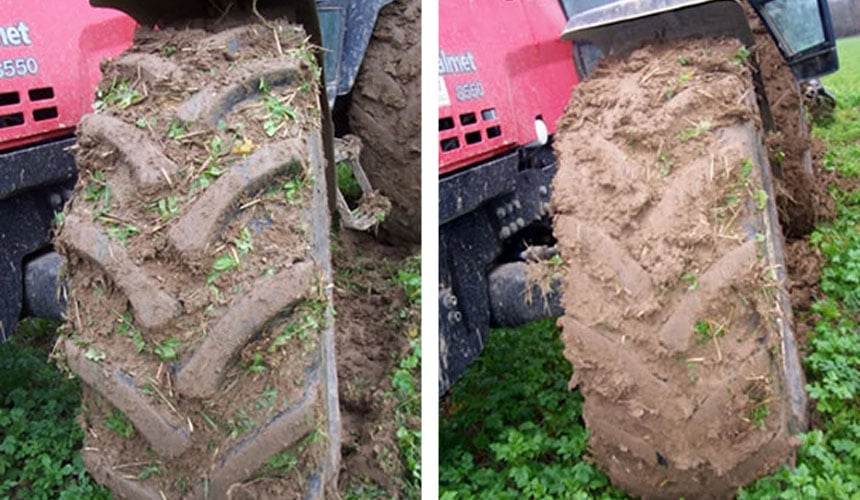
A larger soil footprint than its competitors with similar tyre dimensions
To obtain a larger soil footprint you can use premium tyres that work at low pressure.
But that is also one of the advantages of the VX-R TRACTOR tyre at the level of its tread design, which allows you to make full use of the section width and work permanently with a larger soil footprint.
If you decrease pressure and reduce speed into the bargain, the footprint will be bigger than the nominal section width, with all the related soil preservation benefits that you would have obtained with VF technology tyres.
This new generation of tyre sets the basis for a section width which is in direct contact with the ground.
It allows you to improve your efficiency and your productivity even further by boosting the capacities of your agricultural machines.
The Bridgestone-agriculture.eu blog is written and administered by tractor tyre experts who are available to provide you with the advice you need on the subject of your agricultural tyres. They allow you to maximise your productivity with information on all subjects linked to tyres: Cheap tractor tyres — Technical data for agricultural tyres — Air pressure advice — Solutions to avoid soil compaction — Sprayer tyre pressure — Why and how to ballast your tractor tyres — When to use dual wheels — The mechanical causes of abnormal wear — Cheap agricultural tyres – etc.
To learn more and boost your farm's profits, Bridgestone-Agriculture is offering you a free, detailed white paper that explains the essential role your agricultural tyres play in your productivity.
Most people who read this article have also read some of the following articles:
- 5 essential techniques to optimise your agricultural tyres
- Why should you check your harvesting tyres before the start of the harvest?
- Which agricultural tyre makes it possible to avoid coming off the rim at low pressure?
- What is the impact of implement settings on tractor tyres?
- Fleet audit: what is the main benefit of agricultural tyres?
- Do you really use the full capacity of your VF agricultural tyres?
- Agricultural tyres: rules for managing the lead ratio
- Managing the load transfer to the front tyres in polycropping
- What are the signs of an incorrect lead ratio?
- Impact of the dynamic rolling circumference of agricultural tyres
This information is intended only to make you aware of the technical and functional aspects of agricultural tires and their use. It does not allow you to make a judgment or a definitive conclusion on a given problem. Only your agricultural tire expert is able to make a technical assessment and take a final decision, case by case.
Leave a
commentary
Your email address will not be published.
Required fields are indicated with *


